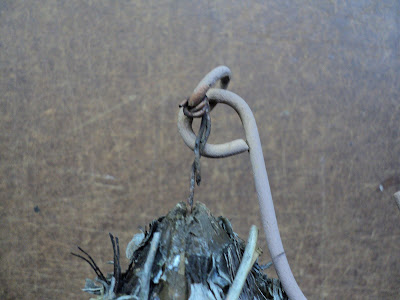We've had some excavation work done at the back of the house for new retaining walls, and the backhoe unearthed this paleolithic
[1] wheel.

And if you think that looks rough, here's the other side.

I'm itching to see what's underneath all the crud. I'll leave it to soak in a bucket of water for awhile, and clean it up.
- - -
MONDAY, MAY 21, 2012
More Crud

The soil washed off easily, but the remaining crud appears to be some sort of weird, hard deposit.
The tire's diameter is 6"; width is 1 7/16". There's no maker's name on it anywhere. Further progress will be by chiseling and scraping.
The Axle
I had to apply my impact wrench to the axle's 3/4" hex head to get it to budge. Then knocking it with a hammer got me to here.

That bearing is a ruin, and the balls for the other side's bearing are nowhere to be seen.
That style of flanged, pressed-steel bearing is still manufactured;
Freeway Corporation is one maker I'm aware of.
I'll press out the outer bearing race that's still in the other side of the wheel, and see if I can get the inner races off the axle. That may be a bit of a challenge.
- - -
TUESDAY, MAY 22, 2012
The Axle Stripped Naked
[Whoops! I appear to have momentarily confused this with my porn blog. 'Sorry.]
I got everything off the axle, and the axle wire-brushed and its thread chased. Here's a view of that.

'Tricks' are for dogs to do, so I won't say, "There's a trick to that." I will say that there's a method.
I set up my hydraulic press to press the races a tiny bit
further onto the axle. By doing that, I was able to break them free of their 'freeze'. Then it was possible to coax them off little-by-little with a hammer and chisel, nudging them along first one side, then the other. The key to getting rust-frozen parts apart is to get them to
budge, even just a little, in any direction. Once a rust-frozen part has budged, odds are good that you can get it loose
The axle is 1/2" diameter, with a 1 1/2" bearing length. The thread is 3/8"-16. That shim washer was under the hex head of the axle. Freeway Corporation's part number ASF-132-1B looks like it will do for replacement bearings.
- - -
MONDAY, JULY 2, 2012
Further Progress
It turns out that my lathe's four-jaw chuck has adequate capacity to accept the wheel, like so.
That will be most helpful.
- - -
SATURDAY, JULY 28, 2012
Some More Progress
Here's the 'good' side of the wheel after various abrasion methods, and a swabbing with lacquer thinner.
That's probably going to have to do for that side. I'd have to make a career of this thing to get it perfect.
By the way, I cheated a bit to get the wheel well-enough centred in the chuck. I used a bull-nose centre in the tailstock to position the wheel, then I carefully tightened the chuck's jaws onto the tire, like so.
That didn't result in a
perfect centring job, but it was good enough for what I was doing, and it saved a lot of fiddling.
The other side of the wheel is in worse condition, and it has some rust holes that will have to be filled. I'll see what I can do with it.
- - -
Painting the Hub --
SUNDAY, DECEMBER 2, 2012
I've filled the rust holes with five-minute epoxy and re-sanded that side of the hub. The thing is as paint-ready as it's going to get, so next is to mask one side for painting. At first, I tried applying masking tape all the way around, like so.
When I trimmed around the hub and removed the unwanted tape, what I had was a botched masking job. Without an unambiguous visual cue for beginning to cut the tape, I'd done a surprisingly poor job of keeping the cut exactly at the edge of the hub. So I started over, applying and cutting tape one section at a time, like so.
That went well, and got me a fully masked wheel after five successive applications of tape.
When the cutting is done, you have to tuck down the cut edge of the tape all around with a fingernail and the back edge of the knife blade, so the tape is tightly down on the tire.
Here's a view of the wheel fully masked and just painted.
And here it is with the mask removed.
I can't claim that it's an absolutely flawless job, but it's pretty good.
Now I just have to repeat the procedure for the other side, leave it for a week for the paint to harden, and I can install the new bearings.
- - -
All Done --
SATURDAY, DECEMBER 8, 2012
Here it is with its new bearings installed and the axle painted.
The bearings dealer cross-referenced the Freeway part number I gave him to a General Bearing P/N 31863-88. That's an exact match for the original bearings, whatever make they were.
With the bearings installed, I was finally able to get the width dimension of the hub at the axle bore -- it's 1 15/32".
So, there we are; quite an improvement over the first few photos.
- - -
Note:
[1] That may be the first time in my life that I've ever used the word 'paleolithic'.
# # #
# # #


















































